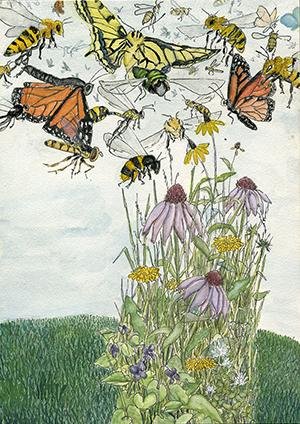
Pesticides include insecticides, fungicides and herbicides. Insecticides are designed to kill insects and depending on formula and concentration can be harmful or fatal to bees and other beneficial insects. Fungicides may have detrimental effects on bee nutrition if they destroy beneficial yeasts and microorganisms in bees’ guts. Herbicides kill the weedy flowers that provide nectar and pollen for bees. Please be safe and judicious with the use of pesticides. Read the label (or look up the active ingredient on the internet) to determine its toxicity to bees. Insecticides have varying toxicity to bees depending on their mode of action and concentration. Herbicides can kill off the flowering "weedy" plants many bees depend on as food. Current research is looking into the effects of some fungicides on bee health. It is very important to apply pesticides only as needed, and to prevent them from persisting as residue in the environment. When using insecticides, it is critical to apply them so they control the pest insect but will avoid affecting foraging bees and other beneficial insects.
Resources
BeeCheck/FieldWatch program
BeeCheck/FieldWatch program in Minnesota. This is a program that allows beekeepers to note the position of their hives on a map (GoogleMap based) so that pesticide applicators can take precautions in those areas.
Protect pollinators while trying to protect your crops
Koch, R.L. and M. Spivak. 2013. Protect pollinators while trying to protect your crops. Minnesota Crop News. August 5, 2013. http://blog-crop-news.extension.umn.edu/2013/08/protect-pollinators-while-trying-to.html
Xerces Society for Invertebrate Conservation Pesticide Information
The Xerces Society for Invertebrate Conservation: www.xerces.org/pesticides/
Getting to Know Commercial Beekeepers
Let's See it from Both Sides: Perspective of Farmers and Beekeepers on the Protection of Honey Bees
Pollinator Conservation Bulletin by Dr. Vera Krischik and Emily Tenczar
The Center for Urban Ecology and Sustainability, Department of Entomology, University of Minnesota (Dr. Vera Krischik) http://cues.cfans.umn.edu/old/pollinators/index.html, "Pollinator Conservation" (.pdf)
Sample paragraph from Dr. Vera Krischik's "Pollinator Conservation" bulletin:
How You Can Help: Understanding Proper Insecticide Use
Dr. Vera Krischik and Emily TenczarThe conservation of beneficial insects, that includes bees, insect predators, parasitic wasps, and butterflies, is an essential part of Integrated Pest management (IPM) programs. IPM promotes multiple tactics to manage pests and to suppress the population size below levels that will damage the plant. IPM tactics include cultural control, sanitation, biological control, using insecticides friendly to beneficial insects, and finally the use of conventional insecticides. IPM recognizes that the few remaining pest insects will support beneficial predators and parasitic wasps. When scouting plants for pest insects, check for populations of both pest and beneficial insects, such as lady beetles and bees. If beneficial insects are present, wait to spray insecticides to see if the beneficial insects control the pest insects or use specific insecticides that only target the pest insect. Do not apply insecticides while plants are in full bloom. If possible avoid beneficial insects by spraying leaves in the evening when bees and lady beetles are not foraging.
FAQ
My neighbors are fogging/spraying their yard for mosquitoes. Will that kill the pollinators in my yard?
The insecticides used in fogs or sprays used for mosquitoes or other biting flies can be very harmful to harm bees and other insect pollinators as well as other beneficial insects. The potential for drift to reach your yard will depend on the direction and speed of the wind. Depending on the insecticide used, residue from the spray could remain toxic to bees foraging on exposed flowers or caterpillars eating the leaves for several weeks.
They are spraying for mosquitoes in my neighborhood. Will it harm my bees?
There are times when it is necessary to spray for mosquitoes to protect the public from mosquito-borne diseases as well as the nuisance the cause. With these programs, precautions are taken to avoid contact with pollinators, reducing but not eliminating risk to pollinators. Find out more by contacting your local mosquito control district. Most districts will have information about spraying available to the public and want to hear your concerns. In the Twin Cities seven-county metro area.
How can I be sure my pollinator plants do not have harmful pesticides?
Even if you ask someone working where you buy plants if a particular plant has been treated with pesticides that could harm pollinators, they may not know. Often, treatments can be applied before plants reach the retail market. It is best to buy pollinators plants from producers who have committed to making sure that their plants are not treated with these pesticides. You can also start many pollinator plants yourself from seed. Seeds can sometimes come with pesticide treatments already applied to the seed coating, so be sure that you also trust your seed source.
